Eurasian BitternLittle BitternNight HeronStriated Heron Squacco Heron Cattle EgretWestern Reef EgretLittle EgretGreat White EgretGrey HeronPurple HeronGoliath Heron
Eurasian Bittern🠉
Botaurus stellaris
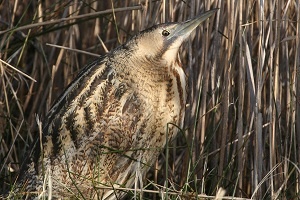
Large, buff-brown coloured heron. More thickset than the Grey Heron, with a thicker neck which is withdrawn between the shoulders most of the time. Legs short. Rarely seen in flight. Wingbeats are faster than in a Grey Heron, the wings are broad, the front end is heavy and the legs protrude. At long range in flight shows a pale patch in the upperwing created by the coverts, which contrast with the dark remiges (which show red-brown barring at close range). The crown and moustachial stripe are black (brown in juveniles). Often seen settled in reedbeds or when disturbed, adopts a characteristic posture, with the neck stretched and the bill pointing upwards.
Voice: flight call “gaoouh”, similar to a gull. Distinctive song a resonant, booming “oump” that can be heard from 5 km away in calm weather, repeated 3 or 4 times.
L. 69-81 cm ; W. 100-130 cm.
Similar species: any in the area.
©Marc Thibault
Little Bittern🠉
Ixobrychus minutus
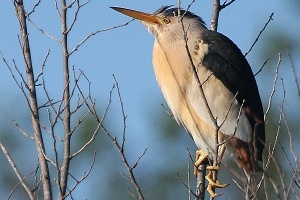
The smallest heron. Often seen briefly in flight when its pale wing panels and rapid wingbeats are distinctive. It is more rarely seen at the edges of reedbeds.
Adult male: crown and upperparts black. Wing panel yellowish-white.
Adult female: crown dark brown. The upperparts are brown in the female, streaked with black. Wing panel buff-brown.
Juvenile: similar to the female but duller. The neck, upperparts and wing panel are streaked.
Voice: flight call a dry “kokkokkok”. Song: a muffled “rroou” repeated every 2 seconds or so.
L. 33-38 cm ; W. 49-58 cm.
Similar species: any in the area.
©Marc Thibault
Night Heron🠉
Nycticorax nycticorax
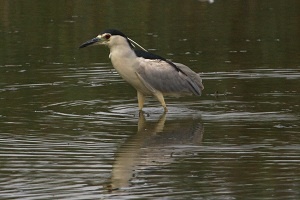
Medium sized heron, thickset with a short, sturdy bill. Frequently seen at dusk and dawn, departing from or arriving at roosts, but also in broad daylight when breeding.
Adult: almost entirely grey apart from the black crown and back. Bill black. Eye red. Legs yellowish (red at egg-laying time).
Juvenile: brown and buff speckled with white spots above and streaked with brown below. Legs pale yellow.
Voice: nasal, raucous “couak”.
L. 58-65 cm ; W. 90-100 cm.
Similar species: Grey Heron, Striated Heron.
©Thomas Galewski
Striated Heron🠉
Butorides striatus
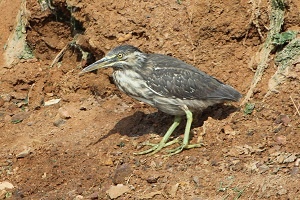
Small dark heron with a long bill. Neck slender when the bird is alert, thickset when relaxed.
Adult: slate-grey, silvery-grey or brown-grey above with the wing coverts edged white, buffish or dark rufous. Sides of the head, neck and chest pale fawn-brown to uniform dark rufous. Bill black and legs yellow.
Juvenile: grey-brown with the wings spotted with white, head and neck strongly streaked dark brown. Size, silhouette and bill-shape different compared with juvenile Night Heron.
Voice : a rough “skow” or a sharp, piercing “skyeh”.
L. 40-48 cm ; W. 52-63 cm.
Similar species: Night Heron, Squacco Heron.
©Thomas Galewski
Squacco Heron 🠉
Ardeola ralloides
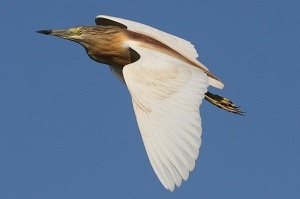
Small buff-coloured heron with white wings. Looks very white in flight.
Adult breeding: long black and white plumes on the head, extending down the back. Sides of the head and neck yellowish. Back ochre. Bill blue with a black tip. Legs yellowish, turning red at egg-laying time.
Adult non-breeding: sides of the head and neck strongly streaked brownish. Back dark ochre-brown. Legs pale yellow. Bill dark brown and yellow.
Juvenile: like the non-breeding adult but even more streaked on the sides of the head and neck. Back darker and duller brown.
Voice: the call is a short, muted “kaak”.
L. 40-49 cm ; W. 71-80 cm.
Similar species: Striated Heron.
©Thomas Galewski
Cattle Egret🠉
Bubulcus ibis
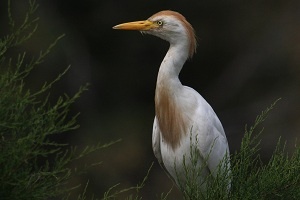
Medium -sized heron with a short bill and a relatively short neck (often held drawn back between the shoulders). Yellow-coloured bill turning reddish at egg-laying time. Legs yellow to grey. Plumage completely white but tinged orangeish in the breeding season.
Voice: low croakings.
L. 45-52 cm ; W. 80-90 cm.
Similar species: Little Egret, Great White Egret.
©Thomas Galewski
Western Reef Egret🠉
Egretta gularis
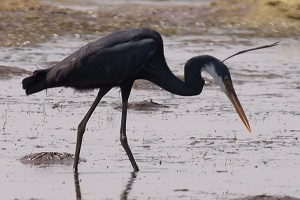
Similar to the Little Egret and occurs in two forms. One white and one slate-grey. The size and shape of the bird are exactly the same as the Little Egret. The bill is usually longer and slightly thicker at the base and may be slightly curved. Its colour varies from blackish to yellow-brown. Legs black to greenish on the lower half of the tarsi. Feet yellow. Immatures can be marked with slate-grey smudges.
Voice: like the Little Egret.
L. 55-68 ; W. 88-112 cm.
Similar species: Little Egret, Great White Egret, Cattle Egret.
©Frédéric Pelsy
Little Egret🠉
Egretta garzetta
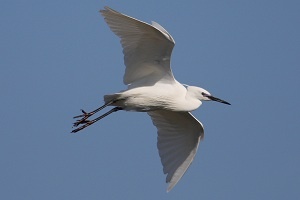
Medium-sized heron, white, slender. Black legs with yellow feet (green in immatures). Bill black. Lores grey-blue to pink. In breeding plumage, two very fine plumes grow from the nape.
Voice: harsh “rrraaah” call.
L. 55-65 cm ; W. 88-106 cm.
Similar species: Great White Egret, Western Reef Egret, Cattle Egret.
©Thomas Galewski
Great White Egret🠉
Casmerodius albus

Large egret, all white. Its size is similar to the Grey Heron. In flight, distinguished from the Little Egret by its size, the slower wingbeats and the proportionally longer legs which extend well beyond the tail. Legs brown, yellowish at the top (red when breeding). The bill, yellow in winter, becomes black in breeding plumage. The lores are green. Shows long plumes on the back in breeding plumage. Distinguished from the Western Reef Egret by the shape of the bill (like a dagger), size, and length of the legs.
Voice: rolling, wooden croaking, “krrraaa”.
L. 85-100 cm ; W. 143-169 cm.
Similar species: Little Egret, Western Reef Egret, Cattle Egret.
©Thomas Galewski
Grey Heron🠉
Ardea cinerea
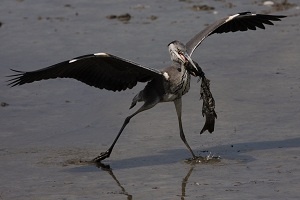
Large sturdily-built heron with the plumage mainly grey and white. Bill strong and deep, grey and yellow (completely orange-yellow in the breeding season). Leg colour greyish-yellow or grey. Flies with the neck retracted (curved) and the wings very bowed, with slow wingbeats, while the medium-length toes are held folded. Upperwing grey with dark grey remiges.
Adult: long black plumes on the nape. Forehead, top of crown and rest of the head white. Neck whitish with black streaks.
Juvenile: forehead and crown dark grey. Nape dark. Sides of the head and the neck grey.
Voice: strong, croaking call, “kah-ahrk”.
L. 84-102 cm ; W. 155-175 cm.
Similar species: Purple Heron, Night Heron.
©Thomas Galewski
Purple Heron🠉
Ardea purpurea

Large heron, of similar size to Grey Heron but slimmer. The bill is also longer, thinner and straighter. In flight, the retracted neck is often more angular, the legs appear longer and the long toes are often held loose. At rest, the bill is often held pointing upwards.
Adult: sides of the head and neck rufous-brown. Neck with distinct narrow black stripes. Back dark grey. Wing coverts uniformly dark grey with a purplish-brown tinge.
Juvenile: sides of head and neck, back and upperwing ochre-brown. Upperparts and wing coverts dark, broadly edged with russet-brown. Neck stripes indistinct.
Voice: call grating and more monosyllabic than Grey Heron, “krehhk”.
L. 70-90 cm ; W. 107-143 cm.
Similar species: Grey Heron, Eurasian Bittern.
©Thomas Galewski
Goliath Heron🠉
Ardea goliath
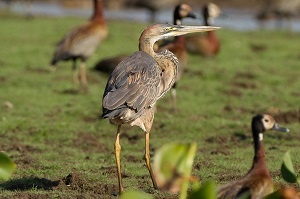
Very large heron of greater size than Grey Heron (the largest of the wading birds) with a very big bill. Upperwing and upperparts bluish-grey. Head, neck (apart from the foreneck) and underparts rusty brown. Foreneck white with a black stripe each side. The bill and legs are grey-black. The adult has a thick reddish-brown crest which is absent in the immature. The immature is also duller. The flight is very heavy and the wingbeats are slow and deep.
Voice: the call is a loud “arrrk”.
L. 135-150 cm ; W. 210-230 cm.
Similar species: Grey Heron, Purple Heron.
©Frédéric Pelsy






